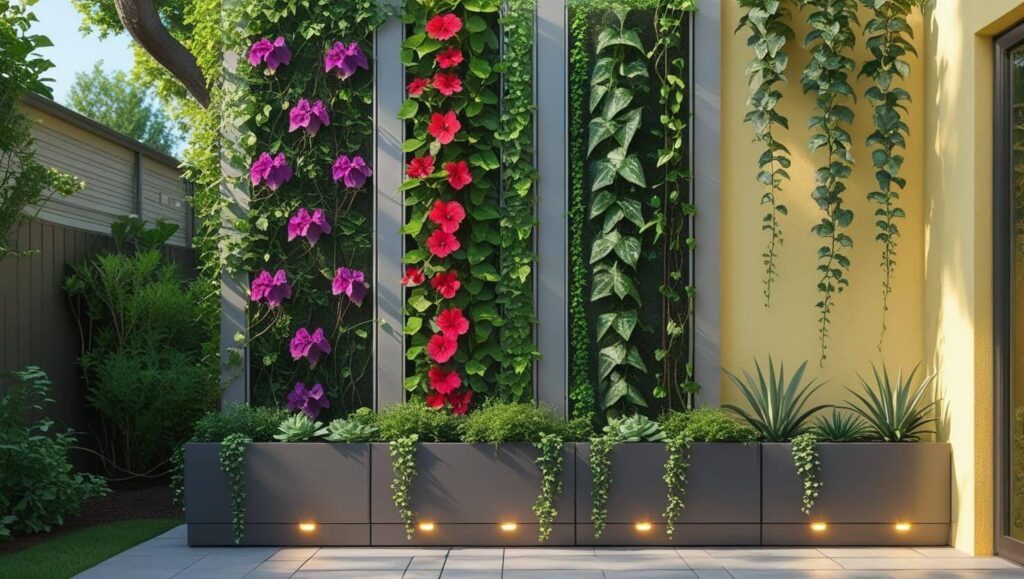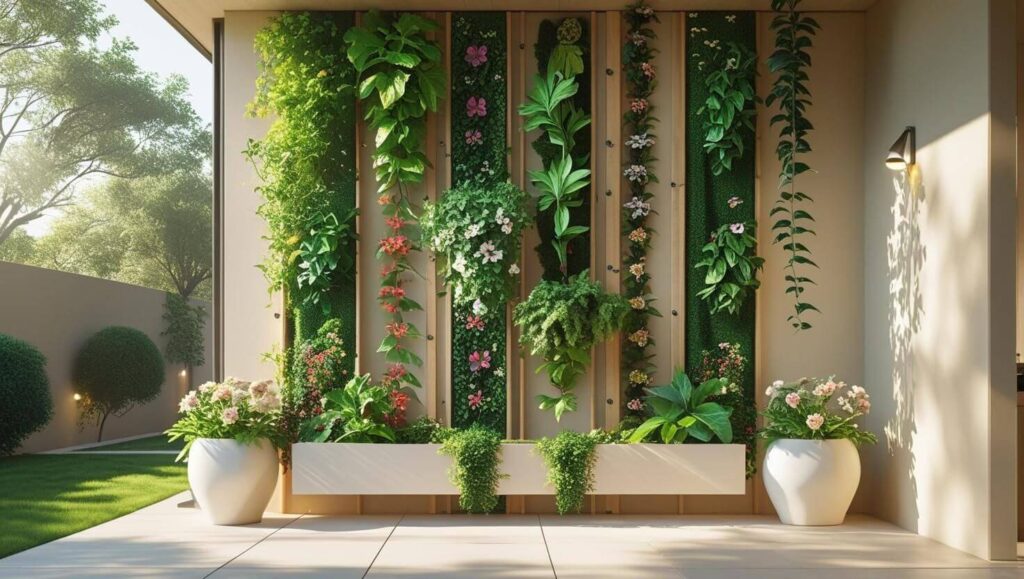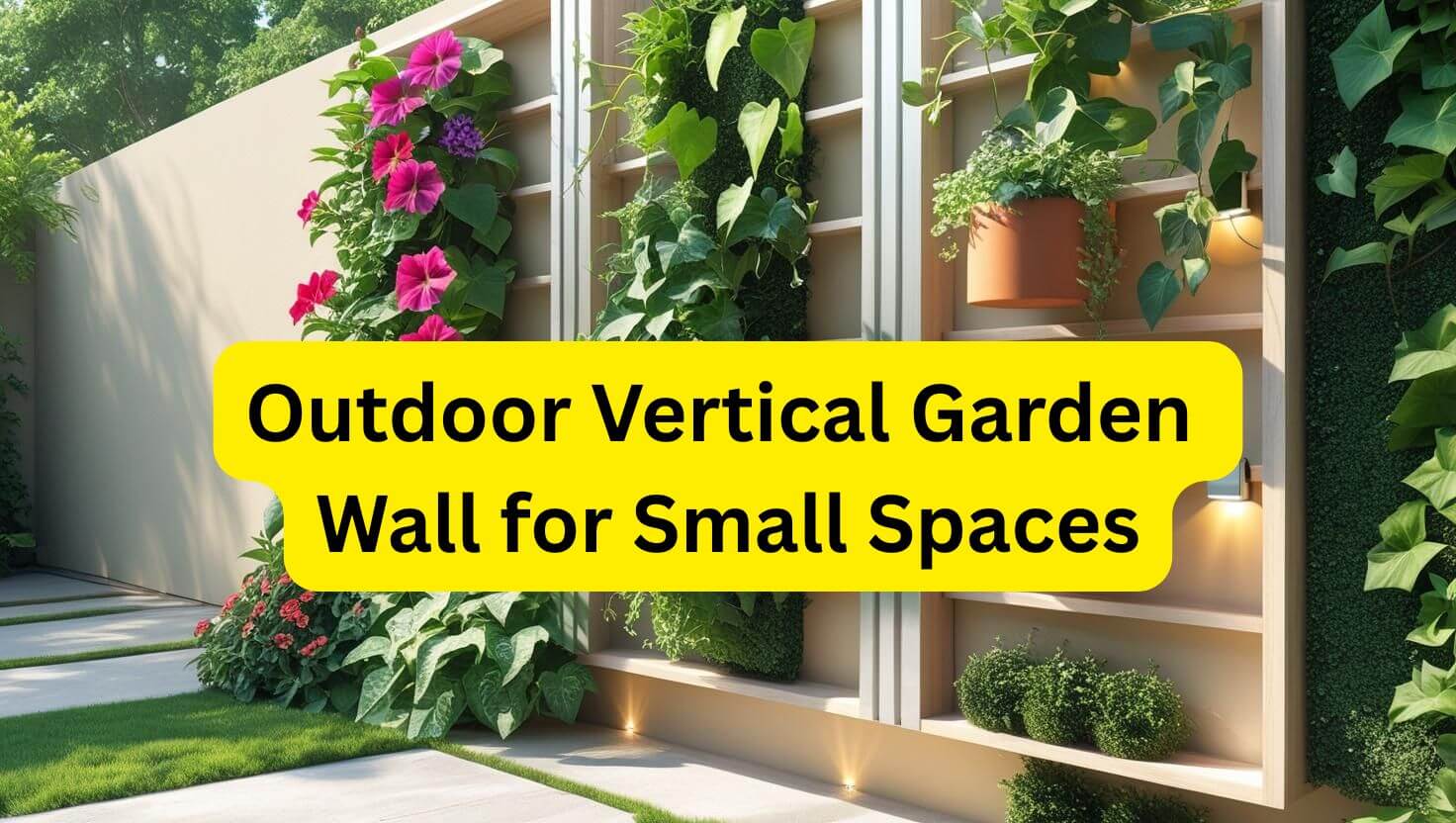As an Amazon Associate, I earn from qualifying purchases.
I always wanted to make the most of my small backyard. One day, I saw a photo of a vertical garden wall. It looked like a living painting! That’s when I thought, “Why not try this at home?” If you’re like me and short on space, this guide is for you.
In this blog, I will guide you through creating an outdoor vertical garden wall using simple tools, low-cost materials, and beginner-friendly steps. If you have a balcony, rooftop, or narrow backyard, vertical gardening is a great solution. It saves space, looks beautiful, and brings the beauty of nature closer to your home. Let’s get started!
Why Should You Try a Vertical Garden Wall at Home?
Do you wonder why vertical gardening is gaining popularity? Let me explain. When I first tried it, I realized it’s not just about saving space. It’s about using your walls for something green and beautiful.
A vertical garden wall is a structure that allows plants to grow upward, rather than spreading out on the ground. You can use wooden frames, recycled plastic bottles, or fabric pockets. The choice is yours.
Here are a few solid reasons why it works:
- Space-saving: You can use walls or fences instead of garden beds.
- Good for small homes: Even apartments can have one on the balcony.
- Clean and organized: No more muddy paths or messy soil.
- Eye-catching: Green walls look amazing and fresh.
- Helps air quality: Plants clean the air around your home.
- Cooler temperature: Plants reduce heat and provide shade.
Note: Vertical gardens are easy to maintain once they’re set up.
It felt great when neighbors asked, “Wow, how did you build that?” That’s the kind of joy this project brings.

What Materials Do You Need to Build a Vertical Garden Wall?
Many people think building a vertical garden is hard. But I’ve done it with simple things I had at home. Let’s break down what you’ll need:
Basic Materials:
- Wooden pallet or frame
- Plastic bottles, pots, or cloth pockets
- Screws or nails
- Strong hooks or brackets
- Gardening soil
- Seeds or plants (like herbs, flowers, or veggies)
- Watering can or drip irrigation pipe
Optional Additions:
- Coco peat or compost
- Fertilizer (organic is better)
- Waterproof backing to protect walls
Here’s a table to help you choose:
| Item | Low Budget | Medium Budget | Best Quality |
|---|---|---|---|
| Frame | Recycled pallet | Wooden planks | Treated wood |
| Pots | Plastic bottles | Cloth pockets | Terracotta pots |
| Soil | Regular garden soil | Mixed soil + compost | Organic soil mix |
Note: Try to recycle materials. It saves money and helps the environment.
How Do You Plan Your Vertical Garden Design?
You might ask, “What’s the best design for me?” Good question! I learned that your garden should match your space, sunlight, and the plants you love.
Here’s how to plan your design:
- Check Your Wall: Is it sunny or shady? North-facing walls may need shade-tolerant plants.
- Measure the Area: Know Your Space Before Buying Materials.
- Choose Your Frame: Pallets, mesh frames, or modular boxes.
- Pick Plants Wisely: Herbs like basil, mint, and coriander are easy to grow. Flowers like petunias or pansies also work well.
- Plan the Layout: Put tall plants at the bottom and short ones at the top. That way, all get sunlight.
I once used only mint and basil in one section. The smell was so good it felt like a spa!
How Do You Build the Vertical Garden Wall Step by Step?
Let’s get to the fun part. Building it!
Step 1: Prepare the Frame. Attach your wooden pallet or mesh to the wall using strong hooks. Make sure it’s stable.
Step 2: Attach Containers. Use nails, wires, or zip ties to fix your pots or containers to the frame. Make sure each container has a small hole at the bottom for water drainage.
Step 3: Fill with Soi.l Add good-quality soil. You can mix garden soil with compost or coco peat.
Step 4: Plant Your Seeds or Seedlings. Choose the right plants. Place them according to the amount of sunlight each section gets.
Step 5: Water Gentl.y Use a small watering can. Or set up a basic drip system with a bottle and small holes.
Step 6: Add Mulch. Mulch helps hold moisture. Dry leaves, bark, or straw can be used.
Step 7: Observ.e Check for pests or dry soil. Fix issues early.
That’s how I built my first one, and I didn’t even spend $20!
How Do You Take Care of a Vertical Garden Wall?
People often ask, “Will it be hard to maintain?” The answer is no, if you take small steps every day.
Here’s how I care for mine:
- Water regularly: Use a spray bottle or drip pipe.
- Check sunlight: Move pots if some plants look dull.
- Trim and harvest: Don’t let plants grow too wild.
- Add compost monthly to help maintain plant health.
- Look for bugs: Use neem spray or soapy water.
Keep a simple journal. Note what works and what doesn’t. Over time, you’ll learn what your wall needs.

What Are the Best Plants for Vertical Garden Walls?
I’ve tried many plants over the years. Some work better than others.
Good Choices:
- Herbs: Mint, basil, thyme, coriander
- Flowers: Marigold, petunia, pansy
- Vegetables: Spinach, lettuce, cherry tomato
- Climbers: Money plant, ivy, philodendron
Avoid heavy plants like pumpkins. They need more support and space.
Here’s a sample table for easy reference:
| Plant Type | Sunlight | Water Need |
| Mint | Partial | Medium |
| Lettuce | Full | High |
| Marigold | Full | Low |
| Money Plant | Low | Low |
Frequently Asked Questions
Q1: How much does it cost to build a vertical garden wall? A: It can cost as low as $10 if you use recycled items. For optimal setups, the cost may increase to $50.
Q2: Can I grow vegetables on a vertical wall? A: Yes! Try spinach, lettuce, or cherry tomatoes. They are light and easy to grow.
Q3: What if my wall doesn’t get much sunlight? A: Choose shade-tolerant plants like snake plant, money plant, or ferns.
Q4: Do I need special soil? A: Use garden soil mixed with compost. Avoid heavy clay soil.
Q5: Can I grow plants all year round? A: Yes, just change your plant types based on the season.
Conclusion
So, have you thought about where you’ll build your vertical garden wall? I hope you feel excited and ready to give it a try. Remember, this method is great for small spaces and brings nature right into your daily life. How to create an outdoor vertical garden wall doesn’t have to be hard. Start small, experiment, and enjoy the green touch it adds to your home.
Once you begin, you might wonder why you didn’t try this earlier. I know I did. It’s fun, peaceful, and something the whole family can enjoy. Happy gardening!

